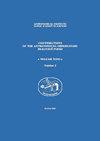食双星KIC 9821078上的点迁移
IF 0.2
4区 物理与天体物理
Q4 ASTRONOMY & ASTROPHYSICS
Contributions of the Astronomical Observatory Skalnate Pleso
Pub Date : 2020-04-06
DOI:10.31577/caosp.2020.50.2.481
引用次数: 0
摘要
从开普勒太空望远镜获得的高精度和连续的光曲线提供了关于冷恒星黑子行为的重要信息。在这项研究中,我们利用光曲线反演方法获得了食双星KIC 9821078的表面图,以揭示开普勒长节奏(LC)光曲线的纵向光斑迁移。我们也提出了一个最新的解决方案,从光和径向速度曲线。反演结果发现,至少有两个主要的黑子区域由于类似太阳的微分旋转而从低经度向高经度迁移。本文章由计算机程序翻译,如有差异,请以英文原文为准。
Spot migration on the eclipsing binary KIC 9821078
High precision and continuous light curves obtained from the Kepler Space Telescope provide significant information about the behavior of cool starspots. In this study, we obtain surface maps of the eclipsing binary KIC 9821078 with the help of the light curve inversion method to reveal longitudinal spot migration from Kepler long-cadence (LC) light curves. We also present an upto-date solution from light and radial velocity curves. The inversion results find at least two dominant spot regions that migrate from lower to higher longitudes as a consequence of solar-like differential rotation.
求助全文
通过发布文献求助,成功后即可免费获取论文全文。
去求助
来源期刊
CiteScore
1.10
自引率
20.00%
发文量
4
审稿时长
>12 weeks
期刊介绍:
Contributions of the Astronomical Observatory Skalnate Pleso" (CAOSP) is published by the Astronomical Institute of the Slovak Academy of Sciences (SAS). The journal publishes new results of astronomical and astrophysical research, preferentially covering the fields of Interplanetary Matter, Stellar Astrophysics and Solar Physics. We publish regular papers, expert comments and review contributions.

 求助内容:
求助内容: 应助结果提醒方式:
应助结果提醒方式:


